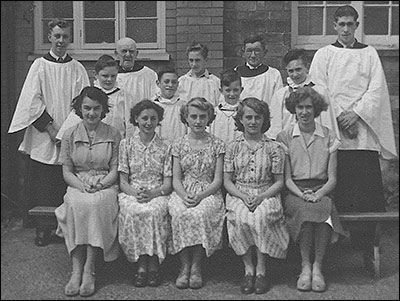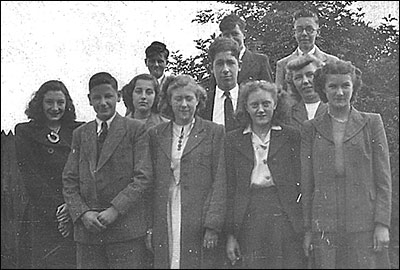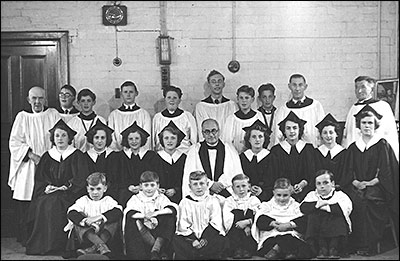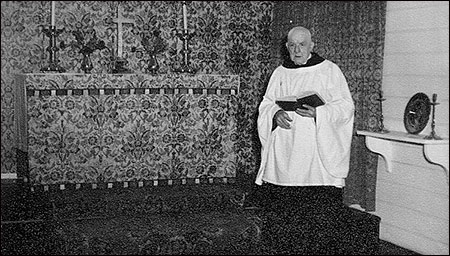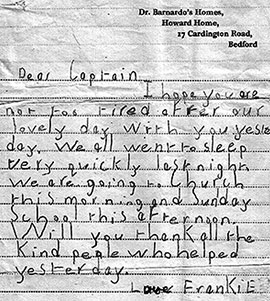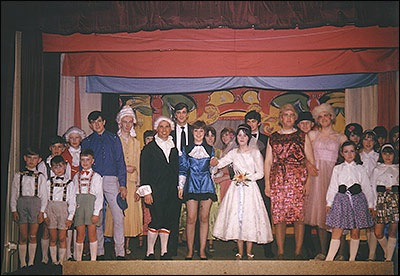| Prepared by Margaret Craddock following an interview with Phil Mason |
||||||||||||||||||||||||||||
|
||||||||||||||||||||||||||||
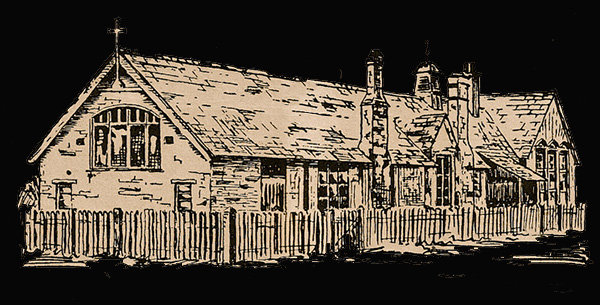 |
||||||||||||||||||||||||||||
|
I understand the Mission Room was built through the generosity of two spinster ladies, the Miss Orlebars who came from Hinwick Hall originally and they lived in a large brick house in the High Street that later became the Cottage Homes. They built it to serve the people of what was then called New Town which I think was an area bordered by The Bible Class met on Sunday afternoons at 3 o’clock just for about an hour. As the years progressed, the original leader Sid Giles moved away with his work and Harold Watson, who was a Manager at the Co-op Clothing Department in the High Street, took over and then after him there was Reg Marriott from Mrs Holyoake was the prime mover of the Sunday School following the establishment by Sid Giles and she always remained the key figure but eventually there became about 12 teachers, mostly younger people. I think Mrs Rene York helped with the infants for a time, there was yourself, there was David Spokes, Roger Drage, myself, Mary Sharman, Mary Wittering, Carole Althorpe, and various other people, usually mostly younger people but there was about a dozen teachers and well over 100 children. The Sunday School met at ten o’clock until eleven o’clock in the mornings and two o’clock until about ten minutes to three in the afternoons. The children had books in which to stick an appropriate biblical stamp each week. We also had an annual outing. We used to go to places like The first Sunday service was held on the Sunday before Christmas 1947 and the Sunday School and the Bible Class, which were quite a bit smaller in those days, took part and also the people who used to attend the Mission Room before the war, people like George Mason, Herbert Tailby and Kit Coles and all those sort of people came along and it was a lovely service. The Revd Sharpley, the Rector at that time, came and took the service and it was the first service for eight years and I can remember we started with “We Love the Place O God” and his sermon was “Well come”, he made it two words “Well” “Come” – its good that you have come back and that was the first service at three o’clock in the afternoon.
Eventually I became organist and choirmaster. Sid Giles’ brother, Ron Giles, was the organist and he was leaving. not to become a cathedral organist but actually to become a bus conductor. So just the fact that I had a vague knowledge of playing the piano it automatically meant that I would become the organist.
The choir plodded along. I don’t think we were ever a very good choir but we did all sorts of other things and had a very enjoyable time. We used to go out for bike rides after choir practice on summer evenings and often ended up doing the garden and having fish and chips at the Mission Room and all sorts of things like that. The first years were quite difficult with small congregations but money was urgently needed for the chancel to be refurbished and the building to be brought into line and a new electronic organ was built and installed, choir robes were purchased and eventually we got a different pulpit and different lectern. The social side was very important. There used to be beetle drives, whist drives, socials and all manner of activities during the week, not only to raise money but also to provide a social life for young people especially and also for older people at this end of the parish.
There would be a social for young people starting at half past seven until eleven o’clock I think it was in the big room and running in at the same time as that was a whist drive that went on from half past seven until nine and the tickets for the whist drive also invited the people to come into the social. So it was a whist drive and social combined and when the whist drive finished and they had had their refreshments they would come into the social. I think it was one shilling for the social and one and six for the whist drive and that included refreshments. There were dances and loads of coffee mornings and coffee evenings and all sorts of activities really. We kept in touch with all the changing social scenes really. It was good. Arthur Turner used to help with the electronic music but before that it used to be Cecil Hickman on the piano and I think I’m right in saying that he had ten shillings and his refreshments. (To read about the Saturday Night Hop click here) To provide heat in the winter there were these Tortoise stoves that absolutely roasted you if you stood or sat near them but you were frozen if you were miles away. I know the one near the choir in the Mission Room, Mr Mason always used to see that there was a container of water on the top but although we then changed it to electric heaters you couldn’t sit round electric heaters and enjoy them like you could the stoves. Various people lit the stoves on Sunday mornings. We did have caretakers. I think the caretakers had the princely sum of five shillings a week or something like that in those days so of course you couldn’t expect them to do too much but they often lit the stoves. Other people kept them going all day and right up to the time of me getting married I was still going back to top up the stoves on a Sunday teatime when I was courting Mary. We had contact with St Andrews youth group at We also used to go on Saturday afternoon walks and bike rides and Sunday evening in the summer after the service we would go for walks taking all the different walks - up to Finedon, or we would go up to Hilltop at Harrowden and then back through Isham or we would go over to the Hurdy Gurdy or we would go up to The Wold or the fields across – which was then a field route from the Scout Hut to Wold Road. All very enjoyable. They were the summer evenings and in the winter evenings there was usually a monthly Squash on every month throughout the year and I think it was the first Sunday in the month when somebody would come and speak and we would sing choruses and drink tea and eat biscuits and that sort of thing. Then when there wasn’t a Squash on in the winter months from October through to February, there was almost always pantomime practises on the Sunday evening when we started to get ready for the pantomime so on a Sunday the Mission Room was open from half-past nine, twenty to ten, on a Sunday morning at least until about ten o’clock on a Sunday evening and busy all the time. The Christmas Day party started when Capt Ron Denniss was here and we realised that there was a need to provide something for people who lived on their own. There were quite a lot of elderly people who lived on their own. Some had relations who lived away, some probably didn’t have anybody but we decided to start a party for people who lived on their own on Christmas Day and that went on for quite a number of years and it was a very happy time. It used to start at about three o’clock in the afternoon and people were transported if they couldn’t get there on foot. Everybody was welcomed at the door and taken in to sit down and the tables were loaded with food and we had tea by candlelight and then a visit from Father Christmas and then an impromptu concert at which the older people often took part and that was absolutely marvellous because they were very good at doing that sort of thing. We usually finished about nine o’clock to nine thirty with a short carol service and I think a good time was had by all. The children used to do a nativity play on Sunday afternoon and then the choir did the Nine Lessons and Carols based on the Another time that was always very busy was the Harvest Festival. It used to start off on Thursday evening at seven-thirty when traditionally the Rector came and preached. That was followed by what we called a Harvest Home in the back room which was just refreshments and a singsong and then on the Sunday morning there would be ten o’clock children’s service, and two o’clock children’s service and often with the children’s services it would be absolutely packed because there were well over a hundred children and we got parents and sometimes grandparents as well. Sunday evenings I used to play the voluntary from six o’clock to six twenty-five and then take a five-minute break because by six o’clock there was usually a good number of people there and by six-thirty it was more or less standing room only. So that was very good. The harvest produce was sold on the Monday night and then again the Rector always came to sell the produce and that was always a very pleasant evening. One thing that happened every harvest sale - there was a lady who lived across the road called Mrs Gertie Ward and she was a very insignificant, lovely lady. She always made brandy snaps for the Harvest Sale. We used to have roast potatoes – jacket potatoes – but Mrs Ward always came across with a load of brandy snap and that really sold like hot cakes.
When Captain Cooke was here the local Doctor Barnados’ representative asked him to run a flag day and he wasn’t keen on running another flag day as we had various flag days we used to run so what happened was we sort of adopted the Howard Home in Cardington Road, Bedford. The children used to come over to The choir also took part in annual pantomimes. Before the pantomimes came into existence, the choir did what we called a nine-penny concert. We used to charge nine pence and put a little concert on in the back room which consisted of musical items and a play and that went down very well and they outgrew the back room so we moved to St John’s Ambulance Hall. Each year for a great number of years we used to run a coach, or two coaches actually, to the Star Hall at Finedon for their annual pantomime which was really, really professional and still is. One year coming back, the girls I think it was in the coach, said “Why can’t we have a pantomime?” and there and then we were committed to a pantomime. The choir was committed to a pantomime but we did used to have to bring one or two other people in simply because it took about sixty people to put the show on the road or put the show in the hall. The first one was Snow White and the Seven Dwarfs simply because we had seven dwarfs and we fitted them in. The dwarfs varied in size. We had some very big dwarfs and some very tiny dwarfs. It was a bit of a worry. We hadn’t got very much experience. The dress rehearsal was a disaster but on the night everything seemed to fit in to place. So the next year we did Cinderella with two nights and we carried on for ten years. We had been having them at the Assembly Rooms but then when the Preston Hall was restored and made good with a new stage we moved to the Preston Hall and ten years later we ran for a week with a Saturday matinee and during those ten years I am absolutely certain that every ticket was sold because we always sold out well before the time. There were always two or three people standing outside just in case anybody didn’t turn up so it was very encouraging.
I wrote the pantomimes. I put the basic bits down and it moved on from there. Other people adding bits as it went along. It didn’t take long. I used to write it on a Saturday lunchtime when I visited
I remember Sailor Beware, a play produced by Capt Denniss. That was absolutely terrific and that again was at the Assembly Room. I was looking after the ticket sales and it was absolutely a sell out a fortnight before and that ran for two or three nights and on the final night we presented Capt Denniss with a brand new moped. The committee who were responsible for the Mission Room made improvements to the building and did raise an enormous amount of money over the years to bring the buildings up to a very good standard, also to get new crockery and furnishings. But when I look back it was very basic with the old Tortoise stoves and hard wooden forms and I often wonder how we drew all these people in such basic conditions because we would never pass the EU. There was just a table up a corner which was the refreshment side of things and one outside toilet shared by everybody even if there was a hundred and fifty there. People didn’t seem to mind; they just seemed to keep coming. My father, Herbert (Bert) Mason, was appointed Secretary when the committee was founded and your father (George Thurlow) was appointed Chairman. Frank Toop was appointed Treasurer. It was a pretty good team. Fred York and yourself were Wardens. When things changed and the Mission Room was no longer in use Frank Toop (in place of Mr York who was too poorly to continue in that position) and yourself were made Deputy Wardens at the Church. It always seems better when you look back in retrospect, but I think the Mission Room served its purpose in that time not only to provide worship which was the first and foremost thing. It provided a basic training for hundreds of children through the Sunday School and not only through the Sunday School - they all took part in the varied social life. Though there sometimes seemed a gap in the congregation between people of teenage years and people who were getting older - there wasn’t many in what I call the middle age group -there was a terrific relation between young people, teenagers and then the older age group. We got a great group of youngsters including quite a lot of men. I think at one point there was about a dozen to fifteen young men who were under twenty, all actively working at the Mission Room and involved on Sunday evening. There weren’t so many in the middle age group but there was a terrific amount of older people and we used to put on teas for the older people before the services and all sorts of dos for them. I think that as well as a worship centre it was also a social centre for that end of the parish and I think that was very important. I think that was also greatly missed afterwards. The decision was taken by Revd Derek Hole to close the Mission Room and I think once the services were removed the actual object and core of everything went, so there was really nothing left, as the committee was disbanded at the same time. I think I felt it was a great pity. I think I realised that there had got to be changes, there was no doubt about that. It wasn’t going to continue the same because the world was changing: people getting their own transport, people were doing different things on Sundays. I think there had got to be changes but bear in mind that when it closed there was a Sunday School of one hundred and twenty-three pupils and a very active social life with, I should think, a congregation of fifty to sixty people all told, so it didn’t close because it wasn’t functional or because it wasn’t meeting a need. It closed because people had different ideas about things, I think. I felt it would have been better if it had been gradually done rather than done very quickly in a matter of about a couple of months or something like that. With hindsight the building could have been used very much at this end of the parish, because there’s not really a church building at this end of the parish. |
||||||||||||||||||||||||||||

